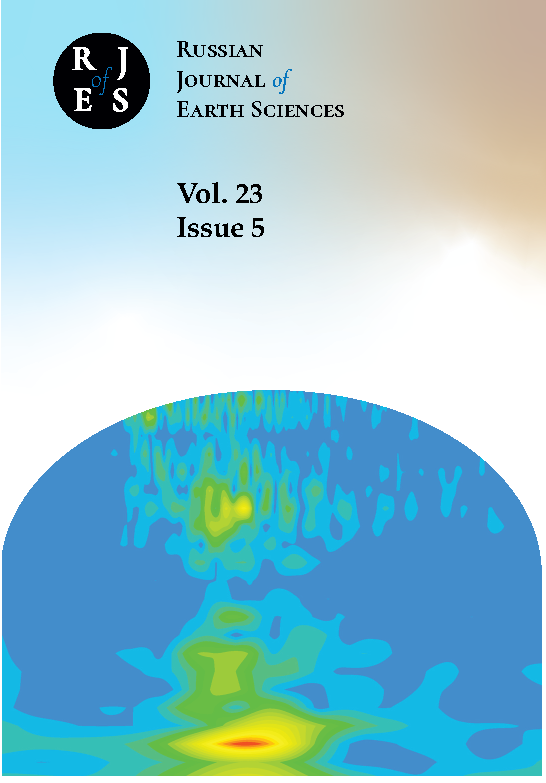Россия
УДК 55 Геология. Геологические и геофизические науки
ГРНТИ 37.00 ГЕОФИЗИКА
ГРНТИ 38.00 ГЕОЛОГИЯ
BISAC SCI SCIENCE
Currently, one of the most important problems is the pollution of natural systems by polycyclic aromatic hydrocarbons (PAHs) as a result of human industrial activity. In this connection, it is necessary to carry out monitoring of territories subjected to the anthropogenic impact. As a result of the monitoring study of the impact zone of the fuel and energy complex enterprises, it was found that polycyclic aromatic hydrocarbons (PAHs) in the soil of the impact zone accumulate mainly up to 2 km along the line of the prevailing wind rose from the enterprise. The group composition of PAHs is dominated by 4-ring compounds, exceeding the background values by 23 times. At the same time, plants growing on the territory of the impact zone mainly accumulate such compounds as fluoranthene, pyrene, benzo[a]anthracene and phenanthrene, which is 70–82% of the total content of polyarenes in various parts of plants.
PAHs, benzo[a]pyrene, monitoring, soil-plants
1. Abdel-Shafy, H. I., and M. S. M. Mansour (2016), A review on polycyclic aromatic hydrocarbons: Source, environmental impact, effect on human health and remediation, Egyptian Journal of Petroleum, 25(1), 107-123, https://doi.org/10.1016/j.ejpe.2015.03.011. EDN: https://elibrary.ru/YEJDKI
2. Chai, C., Q. Cheng, J. Wu, L. Zeng, Q. Chen, X. Zhu, D. Ma, and W. Ge (2017), Contamination, source identification, and risk assessment of polycyclic aromatic hydrocarbons in the soils of vegetable greenhouses in Shandong, China, Ecotoxicology and Environmental Safety, 142, 181-188, https://doi.org/10.1016/j.ecoenv.2017.04.014.
3. Cristale, J., F. S. Silva, G. J. Zocolo, and M. R. R. Marchi (2012), Influence of sugarcane burning on indoor/outdoor PAH air pollution in Brazil, Environmental Pollution, 169, 210-216, https://doi.org/10.1016/j.envpol.2012.03.045.
4. GN 2.1.7.2041-06 (2006), Maximum Permissible Concentrations (MPC) and Estimated Permissible Concentrations (APC) of chemicals in soil: Hygienic standards (in Russian).
5. GOST 17.4.3.01-2017 (2019), Nature protection. Soils. General requirement for sampling (in Russian).
6. Kołtowski, M., I. Hilber, T. D. Bucheli, and P. Oleszczuk (2016), Effect of activated carbon and biochars on the bioavailability of polycyclic aromatic hydrocarbons in different industrially contaminated soils, Environmental Science and Pollution Research, 23(11), 11,058-11,068, https://doi.org/10.1007/s11356-016-6196-1.
7. Kotoky, R., and P. Pandey (2018), Plant-microbe Symbiosis as an Instrument for the Mobilization and Removal of Heavy Metals from Contaminated Soils - A Realistic Approach, Current Biotechnology, 7(2), 71-79, https://doi.org/10.2174/2211550106666170321104354.
8. Kumar, S. S., A. Kadier, S. K. Malyan, A. Ahmad, and N. R. Bishnoi (2017), Phytoremediation and Rhizoremediation: Uptake, Mobilization and Sequestration of Heavy Metals by Plants, in Plant-Microbe Interactions in Agro-Ecological Perspectives, pp. 367-394, Springer Singapore, https://doi.org/10.1007/978-981-10-6593-4_15. EDN: https://elibrary.ru/YHBYYX
9. Kuppusamy, S., P. Thavamani, K. Venkateswarlu, Y. B. Lee, R. Naidu, and M. Megharaj (2017), Remediation approaches for polycyclic aromatic hydrocarbons (PAHs) contaminated soils: Technological constraints, emerging trends and future directions, Chemosphere, 168, 944-968, https://doi.org/10.1016/j.chemosphere.2016.10.115. EDN: https://elibrary.ru/YVYPTB
10. Medunić, G., M. Ahel, I. B. Mihalić, V. G. Srček, N. Kopjar, Ž. Fiket, T. Bituh, and I. Mikac (2016), Toxic airborne S, PAH, and trace element legacy of the superhigh-organic-sulphur Raša coal combustion: Cytotoxicity and genotoxicity assessment of soil and ash, Science of The Total Environment, 566-567, 306-319, https://doi.org/10.1016/j.scitotenv.2016.05.096.
11. Sasse, J., E. Martinoia, and T. Northen (2018), Feed Your Friends: Do Plant Exudates Shape the Root Microbiome?, Trends in Plant Science, 23(1), 25-41, https://doi.org/10.1016/j.tplants.2017.09.003.
12. Sushkova, S. N., G. K. Vasilyeva, T. M. Minkina, S. S. Mandzhieva, I. G. Tjurina, S. I. Kolesnikov, R. Kizilkaya, and T. Askin (2014), New method for benzo[a]pyrene analysis in plant material using subcritical water extraction, Journal of Geochemical Exploration, 144, 267-272, https://doi.org/10.1016/j.gexplo.2014.02.018. EDN: https://elibrary.ru/UESZVB
13. Sushkova, S. N., T. M. Minkina, S. S. Mandzhieva, G. K. Vasilyeva, N. I. Borisenko, I. G. Turina, O. V. Bolotova, T. V. Varduni, and R. Kızılkaya (2015), New alternative method of benzo[a]pyrene extractionfrom soils and its approbation in soil under technogenic pressure, Journal of Soils and Sediments, 16(4), 1323-1329, https://doi.org/10.1007/s11368-015-1104-8. EDN: https://elibrary.ru/WTPGVV
14. Tobiszewski, M., and J. Namieśnik (2012), PAH diagnostic ratios for the identification of pollution emission sources, Environmental Pollution, 162, 110-119, https://doi.org/10.1016/j.envpol.2011.10.025.
15. Tsibart, A. S., and A. N. Gennadiev (2013), Polycyclic Aromatic Hydrocarbons in Soils: Sources, Behavior, Indicative Value (A Review), Pochvovedenie, 7, 788-802, https://doi.org/10.7868/S0032180X13070125 (in Russian). EDN: https://elibrary.ru/QCMTOB
16. US Environmental Protection Agency (2020), Integrated Risk Information System (IRIS), https://cfpub.epa.gov/ncea/iris_drafts/AtoZ.cfm, (date of access 10.07.2023).
17. Wood, J. L., C. Tang, and A. E. Franks (2016), Microbial associated plant growth and heavy metal accumulation to improve phytoextraction of contaminated soils, Soil Biology and Biochemistry, 103, 131-137, https://doi.org/10.1016/j.soilbio.2016.08.021. EDN: https://elibrary.ru/ULWIOJ
18. Yakovleva, E. V., V. A. Beznosikov, B. M. Kondratenok, D. N. Gabov, and M. I. Vasilevich (2008), Bioaccumulation of polycyclic aromatic hydrocarbons in the soil-plant system, Agrochemistry, 9, 66-74 (in Russian). EDN: https://elibrary.ru/JRFMVF
19. Yunker, M. B., A. Perreault, and C. J. Lowe (2012), Source apportionment of elevated PAH concentrations in sediments near deep marine outfalls in Esquimalt and Victoria, BC, Canada: Is coal from an 1891 shipwreck the source?, Organic Geochemistry, 46, 12-37, https://doi.org/10.1016/j.orggeochem.2012.01.006.















